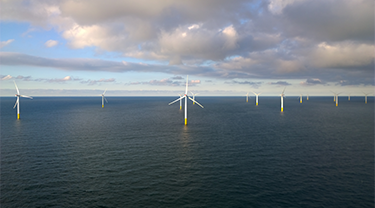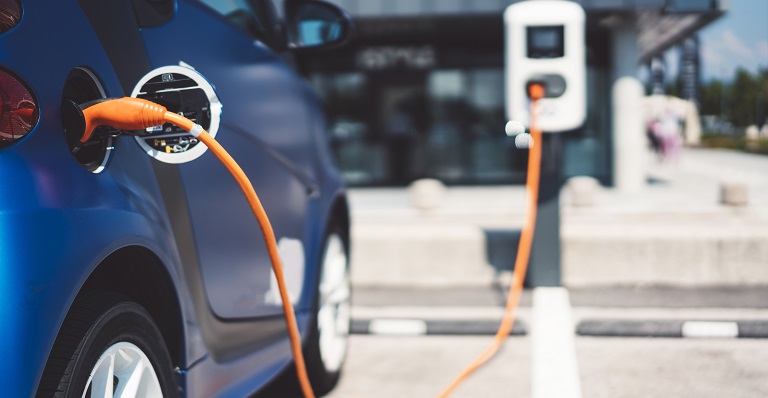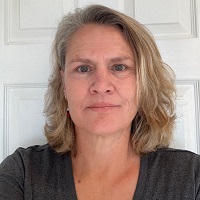For some companies, energy transition and government policies to reduce industry greenhouse gas emissions are a burden. For Northland Power Inc. (Northland), they’re an opportunity.
Northland launched in 1987 as an independent energy company that produced electricity from natural gas. Originally, its focus on gas was to support decarbonization of Ontario and Saskatchewan from coal. But in 2013, the company recognized the growing global demand for cleaner energy and shifted its focus to renewables—specifically, offshore wind power.
In just 10 years, it’s become a leading global developer and operator of offshore wind energy, and its commitment to green power has paid off in a big way.
“Today, over half of our cash flow comes from offshore wind projects and by 2027, we expect to have an offshore wind operating capacity of about 3.4 gigawatts,” says Adam Beaumont, Northland’s interim chief financial officer .
For Northland, 2023 was a transformational year. The Toronto-based company secured financing on two landmark transactions: The first offshore wind farm in Poland, and the company’s first investment in Asia. Together, these projects will more than double its global offshore wind capacity.
Pivoting to offshore wind energy was an opportunity for Northland to differentiate itself from its global competitors. The company also recognized that long-term power contracts for large-scale wind energy would offer stability to shareholders. The benefits to transitioning were many:
- Diversifying away from gas would make Northland financially stronger and operationally more resilient—its North American power generation could be complemented by offshore wind in the European Union (EU) and Asia, and potentially, solar or storage elsewhere.
- Being an early mover would provide an advantage over Northland’s global competitors.
- Operating in various markets de-risks its energy production profile through diversification.
- Note: There are no offshore wind farms operating in Canada currently. Looking beyond its borders allowed Northland to benefit from opportunities and transform into the global offshore wind leader it is today.
But a transition of this scale and expanding into new markets requires significant financial support and trusted partners.
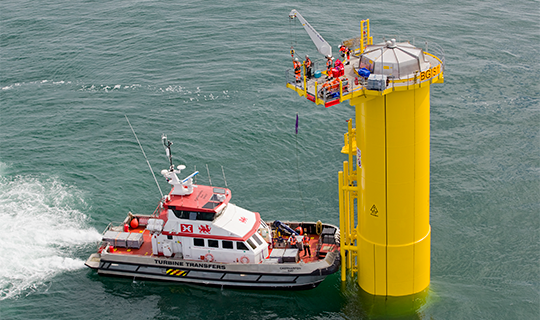
Building of the Gemini project offshore wind farm
Northland’s first big European investment was the Gemini project, a 600-megawatt wind farm off the Netherlands coast—the largest at the time.
The project was one of the industry’s first early-stage offshore wind developments. Projects of this size are costly, and Northland knew it would need external sources of financing. But it faced challenges getting support from banks, given the innovative nature of the project and that this was its first offshore wind project with no track record for executing projects at this scale. In 2013, they turned to Export Development Canada (EDC).
As Canada’s export credit agency, EDC saw Gemini as a landmark project, which could cement Northland’s position as a leader in the sector and support its future growth.
“If EDC can support a project having done detailed analysis on the project—its counterparties and risks, etc.— it shows our commitment to Northland and will help more financial institutions have confidence in the company’s ability to execute such a large investment,” says Tushar Handiekar, EDC’s vice-president of Structured and Project Finance.
EDC’s solution to Northland’s financial challenge was (and continues to be) project financing.
“Project financing is different from lending to a corporate, where a parent company’s assets and revenue can be used to guarantee debt repayment,” Handiekar explains. “In the project financing world, the debt used to finance the project is repaid solely from the cash flow generated by the project. This typically allows for longer debt repayment and multiple parties to share the risk and financing needs among a group of financers for the size and complexity of these kinds of projects,” he says.
EDC has one of the largest project finance teams within the Canadian financial institutions system, with experience in supporting global projects across the world.
Since 2012, EDC has facilitated nearly $41 billion in cleantech exports and is a leading financier of Canada’s cleantech industry. In 10 years, the global cleantech market is expected to reach $26 trillion, offering myriad opportunities for Canadian innovation.
Exporting to new markets—namely, in Europe and the Indo-Pacific—is key to Northland’s growth strategy.
“Most countries in these regions wish to decarbonize and improve energy security, so they have ambitious growth targets,” Beaumont says. “By 2035, global offshore wind deployment is set to grow eightfold to reach 500 gigawatts, with most of that growth coming from Europe and Asia.”
To put this number in perspective, it’s three times the total electrical capacity for all of Canada in 2021.
The European renewables sector has strong support from the European Green Deal program, which aims to achieve climate neutrality in the EU by 2050. This creates a strong appetite across Europe for cleantech products to help them meet their net zero goals. As a result, the EU has taken a leading role in the wind sector, with many industry giants setting up headquarters there.
In Asia, Taiwan’s target is to add 20 gigawatts of renewable energy capacity to its energy mix by 2025. Being an island that relies heavily on oil, coal and gas, it’s a good market for wind power because of the speed of the wind around its coasts and its willingness to adopt wind as part of its net zero goals.
In South Korea, the total installed generation capacity is expected to double by 2050, with renewables accounting for approximately 59%. Offshore wind will make up almost half of this renewable generation, presenting a big opportunity for the industry and an exciting trend in decarbonization.
Northland expects other countries in the Indo-Pacific to follow on the same trajectory. Capitalizing on these growth opportunities requires strong financial partners, like EDC.
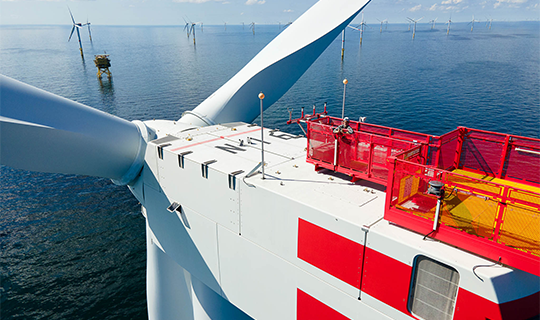
Nordsee One offshore wind farm
In 2014, following Gemini, EDC supported Northland with Nordsee One, a 332-megawatt offshore wind project in Germany. And when it came time to refinance Northland’s nearby 252-megawatt Deutsche Bucht offshore wind farm, EDC was eager to help again.
Our support has expanded over time to enable Northland to grow further with other types of corporate lending such as an Account Performance Security Guarantee (APSG). The APSG supports collateral requirements for the issuance of letters of credit to help increase access to working capital.
“When there’s a potential gap in financial services for a company such as Northland, you need to get creative with solutions to support their strategy moving forward,” Handiekar says.
Once all three offshore wind farms were up and running, Northland looked to simultaneously expand its wind expertise into Poland and Taiwan—at considerable scale.
Poland depends heavily on coal-based energy, but wants to decarbonize its economy. With its strong, steady air currents, its Baltic coast is ideal for wind generation. This led to the 1.1-gigawatt Baltic Power Project, which is the first offshore wind farm in Poland. It’ll power more than 1.5 million Polish households when completed. EDC, along with other financing partners, provided Northland with the needed financing for the project.
The Taiwan offshore wind project—the Hai Long Project—is Northland’s first offshore wind project in Asia. With an output of 1,022 megawatts, it’ll power approximately one million Taiwanese households when it’s fully operable.
“EDC was involved early on in the project and provided support through a financial guarantee,” says Handiekar. “This enabled international and Taiwanese banks to lend money to the project in Taiwanese dollars, because EDC guaranteed repayment.
“That was very important because it brought different regional banks and life insurance companies to the table, that otherwise wouldn’t have been able to participate. Through the guarantees, EDC was able to help Northland and its co-investor, Mitsui, finance the project,” he says.
You should also check out
Rapidly growing sector remains resilient despite turbulent headwinds
Part of Northland’s successful expansion is due to its determination to be an early mover in renewable power.
“We do this, particularly, when entering new or challenging markets, where there are opportunities for long-term contracts and upfront lease fees aren’t prohibitively high,” says Beaumont.
Expanding into new global markets can be risky. To mitigate risk, Northland found local partners and suppliers familiar with the political and environmental regulations.
“Our early-to-market approach has allowed us to establish a significant presence, not only in the European offshore wind industry, but also in Asian markets, like Taiwan” says Beaumont. “EDC’s support has been pivotal to Northland’s ability to grow in these regions, which is why EDC has become Northland’s largest capital provider globally.”
Northland is committed to helping decarbonize the global economy with a corporate goal of reaching net zero by 2040. This initiative centres on developing low-carbon projects, while operating as efficiently as possible, and includes partnering with local communities to build and grow renewable infrastructure.
“Northland has become a global player, going from a company with $1 billion in sales in 2016 to $2.5 billion now,” says Handiekar. “EDC’S support for cleantech has also grown to a multi-billion-dollar book of business. In 2023 alone, our support topped $12.2 billion.
“Supporting Canadian cleantech companies’ growth in international markets, including large-scale renewable energy projects, is a key part of our sustainable finance goals,” he says.
After the Baltic Power and Hai Long wind projects, Northland plans to expand into the Indo-Pacific, most likely Korea, where the company already has a project pipeline.
“It’s a region where we expect to continue working with our financial partners to undertake new projects,” says Beaumont.
For more information about cleantech, the EU and the Indo-Pacific region, check out these EDC resources:
